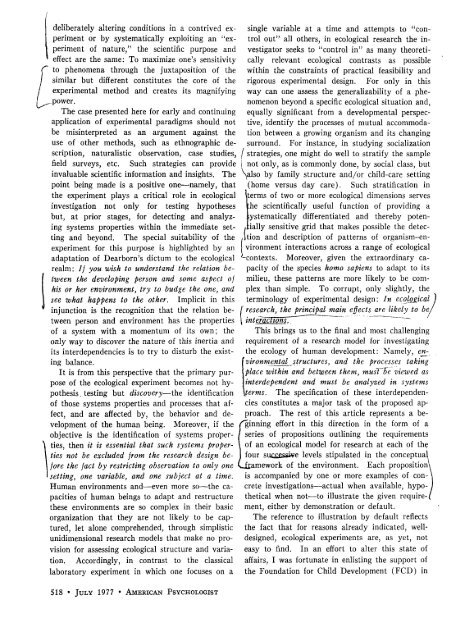Bronfenbrenner 1977
Create successful ePaper yourself
Turn your PDF publications into a flip-book with our unique Google optimized e-Paper software.
deliberately altering conditions in a contrived experiment<br />
or by systematically exploiting an "experiment<br />
of nature," the scientific purpose and<br />
effect are the same: To maximize one's sensitivity<br />
to phenomena through the juxtaposition of the<br />
similar but different constitutes the core of the<br />
experimental method and creates its magnifying<br />
.power.<br />
The case presented here for early and continuing<br />
application of experimental paradigms should not<br />
be misinterpreted as an argument against the<br />
use of other methods, such as ethnographic description,<br />
naturalistic observation, case studies,<br />
field surveys, etc. Such strategies can provide<br />
invaluable scientific information and insights. The<br />
point being made is a positive one—namely, that<br />
the experiment plays a critical role in ecological<br />
investigation not only for testing hypotheses<br />
but, at prior stages, for detecting and analyzing<br />
systems properties within the immediate setting<br />
and beyond. The special suitability of the<br />
experiment for this purpose is highlighted by an<br />
adaptation of Dearborn's dictum to the ecological<br />
realm: // you wish to understand the relation between<br />
the developing person and some aspect of<br />
his or her environment, try to budge the one, and<br />
see what happens to the other. Implicit in this<br />
injunction is the recognition that the relation between<br />
person and environment has the properties<br />
of a system with a momentum of its own; the<br />
only way to discover the nature of this inertia and<br />
its interdependencies is to try to disturb the existing<br />
balance.<br />
It is from this perspective that the primary purpose<br />
of the ecological experiment becomes not hypothesis.<br />
testing but discovery—the identification<br />
of those systems properties and processes that affect,<br />
and are affected by, the behavior and development<br />
of the human being. Moreover, if the<br />
objective is the identification of systems properties,<br />
then it is essential that such systems properties<br />
not be excluded from the research design before<br />
the fact by restricting observation to only one<br />
setting, one variable, and one subject at a time.<br />
Human environments and—even more so—the capacities<br />
of human beings to adapt and restructure<br />
these environments are so complex in their basic<br />
organization that they are not likely to be captured,<br />
let alone comprehended, through simplistic<br />
unidimensional research models that make no provision<br />
for assessing ecological structure and variation.<br />
Accordingly, in contrast to the classical<br />
laboratory experiment in which one focuses on a<br />
518 • JULY <strong>1977</strong> • AMERICAN PSYCHOLOGIST<br />
single variable at a time and attempts to "control<br />
out" all others, in ecological research the investigator<br />
seeks to "control in" as many theoretically<br />
relevant ecological contrasts as possible<br />
within the constraints of practical feasibility and<br />
rigorous experimental design. For only in this<br />
way can one assess the generalizability of a phenomenon<br />
beyond a specific ecological situation and,<br />
equally significant from a developmental perspective,<br />
identify the processes of mutual accommodation<br />
between a growing organism and its changing<br />
surround. For instance, in studying socialization<br />
I strategies, one might do well to stratify the sample<br />
i not only, as is commonly done, by social class, but<br />
\also by family structure and/or child-care setting<br />
(home versus day care). Such stratification in<br />
terms of two or more ecological dimensions serves<br />
he scientifically useful function of providing a<br />
lystematically differentiated and thereby poten-<br />
,iially sensitive grid that makes possible the detec-<br />
Jtion and description of patterns of organism-environment<br />
interactions across a range of ecological<br />
'-contexts. Moreover, given the extraordinary capacity<br />
of the species homo sapiens to adapt to its<br />
milieu, these patterns are more likely to be complex<br />
than simple. To corrupt, only slightly, the<br />
terminology of experimental design: In ecological<br />
1<br />
research, the principal main effects are likely to be/<br />
interactions^ ~<br />
This brings us to the final and most challenging<br />
requirement of a research model for investigating<br />
the ecology of human development: Namely, environmental^<br />
structures, and the processes taking<br />
place within and between them, musT be viewed as<br />
interdependent and must be analyzed in systems<br />
terms. The specification of these interdependencies<br />
constitutes a major task of the proposed approach.<br />
The rest of this article represents a beginning<br />
effort in this direction in the form of a<br />
series of propositions outlining the requirements<br />
of an ecological model for research at each of the<br />
four successive levels stipulated in the conceptual<br />
Ciramework of the environment. Each proposition^<br />
is accompanied by one or more examples of con- \<br />
crete investigations—actual when available, hypo- I<br />
thetical when not—to illustrate the given require-/<br />
ment, either by demonstration or default.<br />
The reference to illustration by default reflects<br />
the fact that for reasons already indicated, welldesigned,<br />
ecological experiments are, as yet, not<br />
easy to find. In an effort to alter this state of<br />
affairs, I was fortunate in enlisting the support of<br />
the Foundation for Child Development (FCD) in


